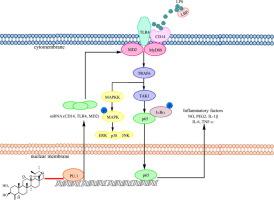Bioorganic Chemistry ( IF 4.5 ) Pub Date : 2021-09-09 , DOI: 10.1016/j.bioorg.2021.105345 Rui Han 1 , Tian Yuan 1 , Zhi Yang 1 , Qiang Zhang 1 , Wei-Wei Wang 1 , Li-Bin Lin 1 , Ming-Qiang Zhu 1 , Jin-Ming Gao 1

|
Chronic neuroinflammation is closely associated with the development of neurodegenerative diseases, including Alzheimer's disease (AD). In the current study, 13 anti-neuroinflammatory compounds were isolated from Eucommia ulmoides Oliv. leaves. Among these compounds, trans-sinapaldehyde (6), 3′,4′,5,7-tetrahydroxy-3-methylflavone (7), and amarusine A (13) were isolated from E. ulmoides leaves for the first time. The ursane-type C29-triterpenoid, ulmoidol (ULM, 9), significantly inhibited the production of proinflammatory mediators and reduced the expression of inducible nitric oxide synthase (iNOS) and cyclooxygenase-2 (COX-2). Moreover, ULM inhibited the cluster of differentiation 14 (CD14)/Toll-like receptor 4 (TLR4) signaling pathway and consequently limited the activation of nuclear factor kappa B (NF-κB) and mitogen-activated protein kinase (MAPK) signaling pathways. Notably, electrophoretic mobility shift assay (EMSA) and molecular docking analyses indicated that ULM could prevent PU box binding-1 (PU.1) from binding to DNA, suggesting that PU.1 might be a potential ULM target. In conclusion, ULM alleviates neuroinflammatory responses in microglia, which could be partly explained by its targeting of PU.1 and the resulting suppression of the TLR4/MAPK/NF-κB signaling pathways. These results suggested that ULM may have therapeutic potential as an agent for treating neuroinflammation-related neurodegenerative diseases.
中文翻译:

Ulmoidol,一种来自杜仲的不寻常的去甲三萜类化合物。叶子通过靶向 PU.1 转录信号通路来预防神经炎症
慢性神经炎症与包括阿尔茨海默病 (AD) 在内的神经退行性疾病的发展密切相关。在目前的研究中,从杜仲中分离出 13 种抗神经炎症化合物。树叶。其中,反式芥子醛( 6 )、3',4',5,7-四羟基-3-甲基黄酮( 7 )和苦参碱A( 13 )为首次从E. ulmoides叶片中分离得到。ursane-type C 29 -triterpenoid, ulmoidol (ULM, 9),显着抑制促炎介质的产生并降低诱导型一氧化氮合酶(iNOS)和环氧合酶2(COX-2)的表达。此外,ULM 抑制分化簇 14 (CD14)/Toll 样受体 4 (TLR4) 信号通路,从而限制核因子 kappa B (NF-κB) 和丝裂原活化蛋白激酶 (MAPK) 信号通路的激活。值得注意的是,电泳迁移率变动分析 (EMSA) 和分子对接分析表明 ULM 可以阻止 PU box binding-1 (PU.1) 与 DNA 结合,这表明 PU.1 可能是潜在的 ULM 靶标。总之,ULM 减轻了小胶质细胞的神经炎症反应,这可以部分解释为它靶向 PU.1 和由此产生的 TLR4/MAPK/NF-κB 信号通路的抑制。











































 京公网安备 11010802027423号
京公网安备 11010802027423号